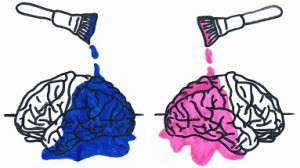Cross-posted from The Neuroethics Blog (Center for Ethics, Neuroethics Program at Emory University)
Baron-Cohen’s main argument is that, on average, men and women have different cognitive strengths and weaknesses: men are more adept at “systematizing” and less adept at “empathizing,” while women are more adept at “empathizing” and less adept at “systematizing.” He goes on to argue that people with autism have “hyper-male” brains (in other words, they are especially good at systemizing and particularly poor at empathizing). According to Baron-Cohen, these differences in cognitive abilities are likely to be the result of genetic differences (both in the case of men and women and in the case of people with autism and people without autism).
I will leave it to others with more knowledge about autism to continue to debate Baron-Cohen’s thesis that autism is characterized by an aptitude for systematizing and by deficits in empathizing abilities, and will focus instead on his argument about sex/gender difference. His argument that these differences are primarily genetic or “hardwired” has been ably critiqued by Lesley Rogers. On average, men and women may have different ways of thinking, but these differences are undoubtedly influenced by gender role socialization (in addition to genetic factors). In societies in which women were denied access to education and were given primary responsibility for childcare, differences in patterns of thinking were most likely exaggerated. In theory, we could further reduce differences (or even reverse the averages) if we sent boys to schools in which only language and social etiquette skills were taught and if we sent girls to schools in which only math, science, and motor skills were taught.[1]
I see an even bigger problem with Baron-Cohen’s argument in how he uses the constructs “empathizing” and “systematizing.” When looking at averages, researchers have found small sex/gender differences in cognitive, motor, and personality characteristics. Yet, these differences have been found in very specific domains (i.e. on average, men may be better at some types of visual-spatial processing while women may be better at some aspects of language processing and some aspects of empathizing).[2] Baron-Cohen chooses to amalgamate all of these different domains under the two constructs of empathizing and systematizing; thereby suggesting that a number of small differences in degree should be seen as two differences in kind (empathic vs. non-empathic and systematizing vs. non-systematizing). By arguing that more men are good systematizers and poor empathizers, and more women are good empathizers and poor systematizers, he thereby suggests that male and female brains (on average) don’t differ from each other by degree in some domains but in fact constitute two different kinds.
And although Baron-Cohen denies it, his definition of what counts as “systematizing” seems highly reliant on gender stereotypes. When talking about boys and men, he sees their interest in memorizing sports statistics as evidence of their systematizing ability. He also sees their preoccupation with gaining social status through force as evidence for their lack of empathizing abilities and as evidence for their abundance of systematizing abilities because, in this case, “social hierarchies are systems” (36). Yet, when talking about girls and women, he interprets their preoccupation with gaining social status through covert actions as evidence of their empathizing abilities but he does not see this as evidence of their systematizing abilities (in this case, social hierarchies are apparently not systems?). Elsewhere, he argues that girls are better at gaining access to a group of strangers because girls are “more likely to stand and watch for awhile in order to find out what is going on, and then try to fit in with the ongoing activity” (42). Again, this is interpreted as evidence for empathizing abilities but not as evidence for systematizing abilities. Why wouldn’t we interpret this, sans evidence to the contrary, as support for the idea that girls are both empathic and systematic?
It seems to me that Baron-Cohen simply takes everything that girls and women do as evidence for their empathizing and “theory of mind” abilities but not as evidence for their systematizing abilities, while taking everything that boys and men do as evidence for their systematizing abilities and as evidence for their lack of empathizing and theory of mind abilities. In this way, Baron-Cohen is simply drawing on the centuries-old association of masculinity with rationality and femininity with emotionality. For me, this raises the question: why do so many scholars, both within cognitive science and within those fields that connect cognitive science to the social sciences and humanities, remain so enamored with Baron-Cohen’s thesis?
[1] For an example of how these differences might be attenuated through learning, see the article“Playing an Action Video Game Reduces Gender Differences in Spatial Cognition” by Feng, Spence, and Pratt (2008).
[2] For a recent review of sex/gender differences in cognitive, motor, and personality characteristics, see Hine 2010. Many studies have tested sex/gender differences in empathy using different measures and have found statistically significant differences between men and women (for a review of sex/gender differences in empathy, see Schulte-Rüther et al 2008). A number of studies have found that on average, men are better at tasks such as targeting, mental rotation, and visuospatial processing (for a recent study of sex/gender differences in targeting abilities, see Moreno-Briseño et al 2010).
